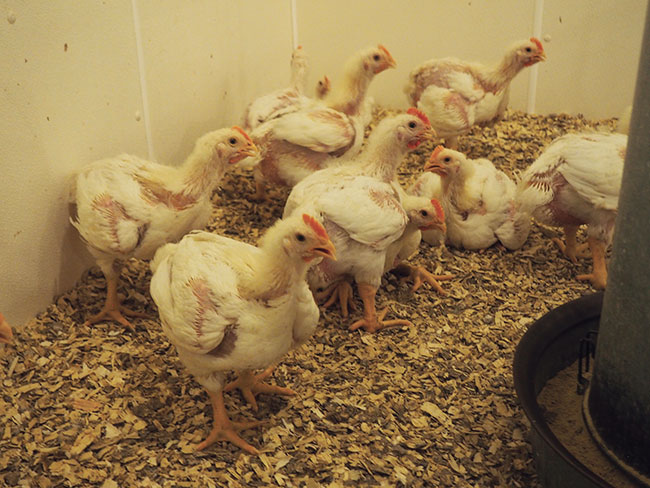
Poultry Nutrition Research: Functional feed
By Jane Robinson
Features Nutrition and FeedCan diet help broilers manage heat stress?
 Broilers are cycled through 12 hours of increased temperatures followed by 12 hours of normal temperatures each day to study the effect of altering nutritional components on heat stress. Photo: Dilshaan Duhra
Broilers are cycled through 12 hours of increased temperatures followed by 12 hours of normal temperatures each day to study the effect of altering nutritional components on heat stress. Photo: Dilshaan Duhra Broilers in the finishing phase naturally generate a lot of heat. They are actively adding weight, and a high metabolic rate produces more body heat. Add in the potential impact of external heat stress as global temperatures rise, and broilers are dealing with heat stress that impacts productivity, and possibly welfare.
To take a closer look at ways to alleviate heat stress, a Saskatchewan research team is working together with an international micronutrient company to investigate the role of nutrition in managing heat stress in broilers.
Drs. Karen Schwean-Lardner and Denise Beaulieu of the University of Saskatchewan are collaborating with German-based Evonik Nutrition on a three-year project looking at how to precisely formulate diets to deliver the appropriate ratio of ingredients broilers need to grow under heat stress. They’ll be studying the impact of changing the bird’s diet during the finisher phase on reducing heat stress.
“Evonik approached us because they were interested in whether we could help alleviate some of the heat stress broilers experience by changing nutritional components of the diet,” says Schwean-Lardner, an Associate Professor of poultry science in the Department of Animal and Poultry Science. “There has been work done recently on heat stress, but we are looking at some different components of the diet and different interactions.”
Schwean-Lardner recruited graduate student Dilshaan Duhra for the project. “I had been working on my masters in British Columbia during the 2021 heat wave, and when I saw the impact on animals it got me interested in studying heat stress,” says Duhra, who is working on his PhD as part of the project.
Heat, nutrition and productivity
All research trials are being conducted at the University of Saskatchewan’s Poultry Teaching and Research Facility, a site specially designed with rooms that can be individually controlled for research purposes and also closely replicate an on-farm setting.
To create a heat stress environment, heat is cycled through bird pens, with 12 hours of increased temperatures followed by 12 hours of normal temperatures, each day during the approximately 14-day finishing phase. This environment will be used in all replications of each trial used to compare different diets.
Every bird is exposed to the cycling heat stress to allow the team to zero in on the effect of altering nutritional components. To evaluate the impact of different diets, Duhra is analyzing and comparing body weight, feed intake, feed-to-gain ratios, meat yield, health status, physiological biomarkers and other welfare factors.
What’s particularly interesting for Schwean-Lardner is the step-by-step approach of the research. The results of each year’s work will feed into the adjustments made to the diet components of the broiler finisher diet for the next year.
Year one feeding trials have finished, and Duhra is analysing the results. “We are looking at how the amount of starch, lipids and proteins will affect animal performance when the birds are under heat stress,” explains Duhra. “We looked at the starch to lipid ratio – in combination with the energy content of the diet – to see how these components interact with each other to influence the bird’s performance under stress.”
Duhra expects to have the year one analysis completed this spring, with the second feeding trial starting in early fall.
Research has already shown that increasing dietary fat in the diet helps alleviate heat stress, as well as decreasing crude protein. Schwean-Lardner says it’s already known which amino acids are limiting in the broiler diet, so they will seek to optimize amino acid concentrations when birds are under heat stress.
What about welfare?
For Schwean-Lardner, another interesting element of this research is to look at the welfare angle. “When broilers are under heat stress, a lot of things happen,” she says. “They become very inactive and lay on litter, which results in a reduced opportunity to dry. So birds are having more contact with that wet litter – leading to lesions in the foot pads, hocks and even the breast. If we can address that by changing components in the diet, maybe birds will be more active and we won’t see as many lesions. We don’t know the answer but hope we find some.”
A recipe to reduce heat stress
This research presents a unique opportunity for research/industry collaboration. “Working together with Evonik is a great experience to help develop practical solutions for the broiler sector,” says Schwean-Lardner. “Our ultimate goal is to create a recipe for managing heat stress that will provide nutritionists and producers with the best approach for feeding through the finishing stage to reduce the impact of heat stress on productivity.”
Print this page